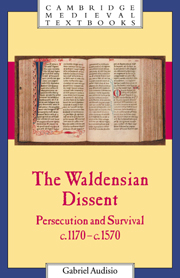Book contents
- Frontmatter
- Contents
- List of maps
- Preface
- Acknowledgements
- Introduction
- 1 1170 – 1215: decisive and purposive origins
- 2 The thirteenth century: the need to adapt
- 3 The fourteenth century: the challenge of believing differently
- 4 The fifteenth century: the risks of longevity
- 5 The constraints of a life in hiding
- 6 The need to organise
- 7 A culture of their own: the written and the spoken word
- 8 The sixteenth century: the end as a way forward?
- 9 Epilogue: the Waldensian Church
- Conclusion
- Bibilography
- Index
- Cambridge Medieval Textbooks
6 - The need to organise
Published online by Cambridge University Press: 05 June 2012
- Frontmatter
- Contents
- List of maps
- Preface
- Acknowledgements
- Introduction
- 1 1170 – 1215: decisive and purposive origins
- 2 The thirteenth century: the need to adapt
- 3 The fourteenth century: the challenge of believing differently
- 4 The fifteenth century: the risks of longevity
- 5 The constraints of a life in hiding
- 6 The need to organise
- 7 A culture of their own: the written and the spoken word
- 8 The sixteenth century: the end as a way forward?
- 9 Epilogue: the Waldensian Church
- Conclusion
- Bibilography
- Index
- Cambridge Medieval Textbooks
Summary
The Poor of Lyons were faced with a crucial decision: should they maintain the intensity of their movement or aim to survive? In other words, live their dissent to the full or live long? Every social unit, from the individual or the family to a micro-society, is faced with such a dilemma at some time or another, whether they are aware of it or not. Should they burst forth and spread, irrespective of those social institutions which might fetter or hamper their spontaneity, or organise and structure their energies so as to last longer, albeit with minor adjustments or compromises? Should they maintain the movement's original, somewhat disorganised impetus and so risk disappearing or ensure their survival by drawing up guiding rules and electing leaders? Vaudes's initial spark kindled the crowds and conquered disciples. The first preachers' words and example encouraged people in their masses to turn back to the gospel and to embrace voluntary poverty. However, once the first burst of enthusiasm had died down and the novelty of the movement had worn off, and in the wake of ecclesiastical reprobation, what came next? When certain brethren returned to the fold of the Roman Church, the choice was, in fact, quite limited. Waldensians could either follow their example, recognising the ‘error’ they had made, or persist in the direction they had chosen, refusing all organisation. In either case, it meant that sooner or later, the movement would disappear.
- Type
- Chapter
- Information
- The Waldensian DissentPersecution and Survival, c.1170–c.1570, pp. 110 - 142Publisher: Cambridge University PressPrint publication year: 1999



